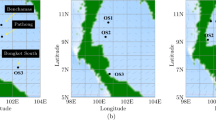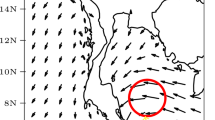Abstract
On June 4 and 17, 2011, two separate oil spill accidents occurred at platforms B and C of the Penglai 19-3 oilfield located in the Bohai Sea, China. Based on the initial oil spill locations detected from the first available Synthetic Aperture Radar (SAR) image acquired on June 11, 2011, we performed a numerical experiment to simulate the potential oil spill beaching area with the General NOAA Operational Modeling Environment (GNOME) model. The model was driven by ocean surface currents from an operational ocean model (Navy Coastal Ocean Model) and surface winds from operational scatterometer measurements (the Advanced Scatterometer). Under the forcing of wind and ocean currents, some of the oil spills reached land along the coast of Qinhuangdao within 12 days. The results also demonstrate that the ocean currents are likely to carry the remaining oil spills along the Bohai coast towards the northeast. The predicted oil spill beaching area was verified by reported in-situ measurements and former studies based on MODIS observations.
Similar content being viewed by others
References
Beegle-Krause C J (2003). Advantages of separating the circulation model and trajectory model: GNOME trajectory model used with outside circulation models. Environment Canada Arctic and Marine Oil Spill Program Technical Seminar (AMOP) Proceedings, 26(2): 825–840
Beegle-Krause C J (2005). General NOAA oil modeling environment (GNOME): a new spill trajectory model. In: Proceedings of International Oil Spill Conference, 3277–3283
Cheng Y, Li X, Xu Q, Garcia-Pineda O, Andersen O B, Pichel W G (2011). SAR observation and model tracking of an oil spill event in coastal waters. Mar Pollut Bull, 62(2): 350–363
Cheng Y, Liu B, Li X, Nunziata F, Xu Q, Ding X, Migliaccio M, Pichel W G (2014). Monitoring of oil spill trajectories with COSMO-SkyMed X-Band SAR images and model simulation. IEEE J Sel Topics Appl Earth Observ in Remote Sens, 7(7): 2895–2901
Farzingohar M, Zelina Z I, Yasemi M (2011). Oil spill modeling of diesel and gasoline with GNOME around Rajaee Port of Bandar Abbas. Iran J Fish Sci, 10: 35–46
Ferraro G, Meyer-Roux S, Muellenhoff O, Pavliha M, Svetak J, Tarchi D, Topouzelis K (2009). Long term monitoring of oil spills in European seas. Int J Remote Sens, 30(3): 627–645
Garcia-Pineda O, Zimmer B, Howard M, Pichel W G, Li X, MacDonald I R (2009). Using SAR image to delineate ocean oil slicks with a texture classifying neural network algorithm (TCNNA). Can J Rem Sens, 35(5): 411–421
Guo J, Liu X, Xie Q (2013). Characteristics of the Bohai Sea oil spill and its impact on the Bohai Sea ecosystem. Chin Sci Bull, 58(19): 2276–2281
Hackett B, Comerma E, Daniel P, Ichikawa H (2009). Marine oil pollution prediction. Oceanography (Wash DC), 22(3): 168–175
Hu C, Li X, Pichel W G, Muller-Karger F E (2009). Detection of natural oil slicks in the NW Gulf of Mexico using MODIS imagery. Geophys Res Lett, 36(1 L01604): L01604
Hu C, Müller-Karger F E, Taylor C, Myhre D, Murch B, Odriozola A L, Godoy G (2003). MODIS detects oil spills in Lake Maracaibo, Venezuela. Eos Trans AGU, 84(33): 313–319
Li X, Li C, Yang Z, Pichel W (2013). SAR imaging of ocean surface oil seep trajectories induced by near inertial oscillation. Remote Sens Environ, 130: 182–187
Li X, Zheng W, Pichel W G, Zou C Z, Clemente-Colón P (2007). Coastal katabatic winds imaged by SAR. Geophys Res Lett, 34(3), L03804, doi: 10.1029/2006GL028055
Liu P, Li X, Qu J, Wang W, Zhao C, Pichel W G (2011). Oil spill detection with fully polarimetric UAVSAR data. Mar Pollut Bull, 62(12): 2611–2618
Martin P J, Barron C N, Smedstad L F, Campbell T J, Wallcraft A J, Rhodes R C, Rowley C, Townsend T L, Carroll S N (2009). User’s manual for the Navy Coastal Ocean Model (NCOM) version 4.0, NRL Report NRL/MR/732009-9151
Migliaccio M, Gambardella A, Tranfaglia M (2007). SAR polarimetry to observe oil spills. IEEE Trans Geosci Rem Sens, 45(2): 506–511
Migliaccio M, Nunziata F, Brown C E, Holt B, Li X F, Pichel W, Shimada M (2012). Polarimetric synthetic aperture radar utilized to track oil spills. EOS, 16(93): 161–168
Remyalekshmi R, Hegde A V (2013). Numerical modeling of oil spill movement along north-west coast of India using GNOME. International Journal of Ocean and Climate Systems, 4(1): 75–86
Solberg A H S, Brekke C, Husoy P O (2007). Oil spill detection in radarsat and envisat sar images. IEEE Trans Geosci Rem Sens, 45(3): 746–755
Sun P, Gao Z, Cao L, Wang X, Zhou Q, Zhao Y, Li G (2011). Application of a step-by-step fingerprinting identification method on a spilled oil accident in the Bohai Sea area. J Ocean Univ China, 10(1): 35–41
Wackerman C, Clemente-Colon P, Pichel W, Li X (2002). A two-scale model to predict C-band VV and HH normalized radar cross section values over the ocean. Can J Rem Sens, 28(3): 367–384
Wang C, Liao M, Li X (2008). Ship detection in SAR image based on the alpha-stable distribution. Sensors, 8(8): 4948–4960
Xu Q, Li X, Wei Y, Tang Z, Cheng Y, Pichel W G (2013). Satellite observations and modeling of oil spill trajectories in the Bohai Sea. Mar Pollut Bull, 71(1–2): 107–116
Xu Q, Lin H, Li X, Zou J, Zheng Q, Pichel W G (2010). Assessment of an analytical model for sea surface wind speed retrieval from spaceborne SAR. Int J Remote Sens, 31(4): 993–1008
Xu Q, Xi H, Zhang Y (2010). Marine pollution in water, sediment and biota. In: Ahmed E N, ed. Impact, Monitoring and Management of Environmental Pollution. Hauppauge NY: Nova Science Pub Inc., 157–191
Yang X, Li X, Zheng Q, Gu X, Pichel W G, Li Z (2011). Comparison of ocean-surface winds retrieved from QuikSCAT scatterometer and Radarsat-1 SAR in offshore waters of the U.S. west coast. IEEE Geosci Remote Sens Lett, 8(1): 163–167
Zhang B, Perrie W, Li X, Pichel W G (2011). Mapping sea surface oil slicks using RADARSAT-2 quad-polarization SAR image. Geophys Res Lett, doi: 10.1029/2011GL047013
Author information
Authors and Affiliations
Corresponding author
Rights and permissions
About this article
Cite this article
Xu, Q., Cheng, Y., Liu, B. et al. Modeling of oil spill beaching along the coast of the Bohai Sea, China. Front. Earth Sci. 9, 637–641 (2015). https://doi.org/10.1007/s11707-015-0515-6
Received:
Accepted:
Published:
Issue Date:
DOI: https://doi.org/10.1007/s11707-015-0515-6




